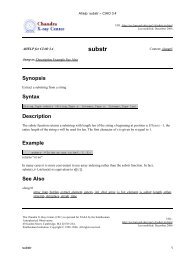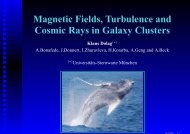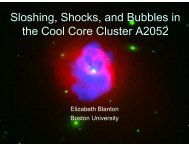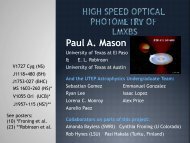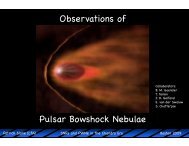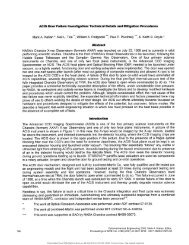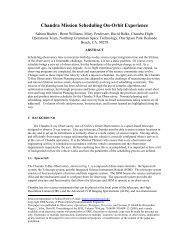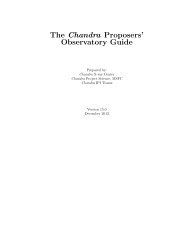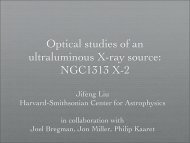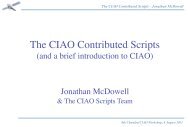PDF Version - Chandra X-Ray Observatory (CXC)
PDF Version - Chandra X-Ray Observatory (CXC)
PDF Version - Chandra X-Ray Observatory (CXC)
You also want an ePaper? Increase the reach of your titles
YUMPU automatically turns print PDFs into web optimized ePapers that Google loves.
12<br />
Fig. 1 - The ratio of the MEG and HEG fluxes as a function of<br />
wavelength, binned to have 1% uncertainties or bin widths less<br />
than 5% of the central wavelength. The sense of the correction<br />
is that the values shown should be applied to the MEG efficiencies<br />
to bring MEG fluxes into agreement with those derived from<br />
HEG data. The dashed line is a 9th order polynomial fit to the<br />
data.<br />
Fig. 1 shows the ratio of the MEG and HEG fluxes<br />
as a function of wavelength, binned to have 1% uncertainties<br />
so that small systematic errors may be found and<br />
corrected. Because the polynomial fit can correct only<br />
the ratio of the MEG and HEG efficiencies, I allocated the<br />
correction to either the HEG or MEG efficiencies: longer<br />
than a specified wavelength, all corrections are applied<br />
to the HEG, while for shorter wavelengths, the MEG is<br />
corrected. The simple reasoning behind the choice is that<br />
it was somewhat easier to determine HEG efficiencies on<br />
the ground at high energies due to the higher resolution<br />
while harder to measure them at low energies due<br />
to significantly lower effective area. Furthermore, the<br />
HEG part of the HETGS dominates observations at high<br />
energy while the MEG part dominates at low energy, so<br />
a “least harm” dictum suggests applying less correction<br />
where a grating part dominates. I tried several possible<br />
cross-over wavelengths and found that 10 Å minimized<br />
the reduced χ 2 in BL Lac fits (see below).<br />
For about 20 observations of AGN, I applied the<br />
new corrections to the HETGS spectra and fit them to<br />
a simple logarithmic parabola model with four parameters:<br />
Eq. 1<br />
n E =Ae -N Hs(E) E -G+blogE<br />
where N H was fixed for each AGN to an estimate based<br />
on 21 cm data (the results are robust against the exact<br />
choice), and the overall model is a power law with a curvature<br />
term, β. The model is the same as that used for BL<br />
<strong>CXC</strong> Newsletter<br />
Fig. 2 (above)- The curvature parameter β, as a function of reduced<br />
χ 2 for fits to HETGS spectra of AGN. See Eq. 1 for the model,<br />
which defines β.<br />
Fig. 3 (below)- The average residuals for curved power law fits to<br />
the HETGS data for 8 BL Lac objects. For most of the HETGS<br />
range, the systematic deviations are not significant or are less than<br />
3%. Deviations of 5–10% near 6 keV and 0.7 keV will be investigated<br />
further.<br />
Lac objects by Perlman et al. 1 . The curvature term is negative<br />
for spectra that are convex upward and positive for those with<br />
soft or hard excesses. Fig. 2 shows that the quality of the fit is<br />
related to the value of β: better fits are obtained for negative<br />
curvature. The fits with positive curvature were predominantly<br />
radio-loud AGN with emission lines, indicating that these<br />
spectra are actually more complex than a simply curving model<br />
provides. For the remaining analysis, the sources with β < 0.3<br />
were chosen; these were the BL Lac objects PKS 2155-304 and<br />
1H 1426-428. The curvature values are similar to those found<br />
for other BL Lac objects 1 .<br />
The spectral residuals for the BL Lac objects were



